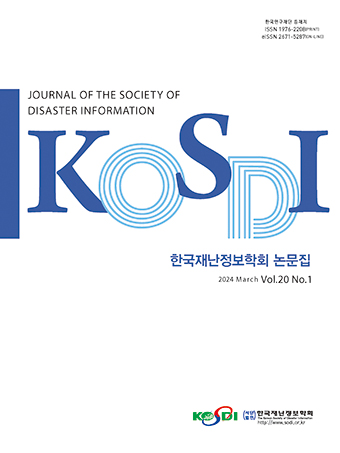Research Article
Abstract
References
Information
Purpose: This study aims to propose a framework for climate change risk management by analyzing characteristics of climate-induced disasters. Method: The recent global and domestic trends of loss and damage under natural disaster events and the characteristics of climate-induced disasters were analyzed to design a framework for climate change risk management. Results: In consideration of the uncertainty of climate risk and various spatio-temporal scales of climate disasters, a new framework is suggested for comprehensive climate risk management that includes risk assessment, goal setting, planning, monitoring and evaluation, learning and adjustment. The framework aims at an iterative process that is activated by stakeholder engagement. Conclusion: Pilot studies need to be conducted to revise and polish the framework in the future, and institutional arrangements should be prepared for the effective implementation of the comprehensive climate risk management.
연구목적: 본 연구는 기후변화에 따른 재난의 특성을 분석하여 기후위험에 대비하기 위한 관리체계를 제시함을 목적으로 한다. 연구방법: 최근 국내외 자연재난으로 인한 피해의 추이를 분석하고 기후변화에 따른 재난의 특성을 파악함으로써 기후위험을 위한 관리체계를 설계한다. 연구결과: 기후변화에 따른 위험의 불확실성과 다양한 규모의 재난을 고려할 때, 위험의 평가에서부터 목표 설정, 계획 수립, 모니터링 및 평가, 학습과 조정 등의 핵심과정을 포함하는 포괄적 기후위험 관리체계가 요구되며, 이는 이해관계자 참여를 바탕으로 지속적으로 반복되는 체계를 의미한다. 결론: 본 연구에서 제시한 포괄적 기후위험 관리체계를 효과적으로 추진하기 위해 시범사업을 통해 관리체계를 수정 및 보완하고, 필요한 제도적 여건을 마련해야 한다.
- Barabasi, A.-L., Bonabeau, E. (2003). “Scale-Free Networks.” Scientific American, Vol. 288, pp. 50-59.10.1038/scientificamerican0503-60 12701331
- BBC (2018). Europe heatwave: Spain and Portugal struggle in 40C+ temperatures (8/4/2018). Retrieved from https://www.bbc.com/news/world-europe-45070498 on 3/29/2019.
- BBC (2019). Australia swelters through record-breaking heatwave (2019.1.18.). Retrieved from https://www.bbc.com/news/world-australia-46886798 on 3/29/2019.
- Birkmann, J., von Teichman, K. (2010). “Integrating Disaster Risk Reduction and Climate Change Adaptation: Key Challenges-Scales, Knowledge, and Norms.” Sustainability Science, Vol. 5, No. 2, pp. 171-184.10.1007/s11625-010-0108-y
- CRED (2019). EM-DAT: The International Disaster Database. Retrieved from https://www.emdat.be on 3/11/2019.
- Ewalt, J. A. G. (2001). “Theories of Governance and New Public Management: Links to Understanding Welfare Policy Implementation.” Paper Presented at the Annual Conference of the American Society for Public Administration, Newark, New York.
- IPCC (2012). Managing the Risks of Extreme Events and Disasters to Advance Climate Change Adaptation. A Special Report of Working Groups and of the Intergovernmental Panel on Climate Change. Cambridge University Press, Cambridge, UK, and New York, NY, USA.
- Kwon, Y.H., Lee, S., Park, C.A. (2015). Measures for strengthening the ecosystem environment security in responding to climate change (Ⅲ), Korea Environment Institute.
- MC(Ministry of Construction) (1986). Annual Disaster Report 1985.
- Mechler, R., Bouwer, L.M., Linnerooth-Bayer, J., Hochrainer-Stigler, S., Aerts, J.C.J.H., Surminski, S., Williges, K. (2014). “Managing Unnatural Disaster Risk from Climate Extremes.” Nature Climate Change, Vol. 4, pp. 235-237.10.1038/nclimate2137
- MHA(Ministry of Home Affairs) (1996). Annual Disaster Report 1995.
- MIS(Ministry of the Interior and Safety) (2017). Annual Disaster Report 2016.
- Moynihan, D.P. (2005). Leveraging Collaborative Networks in Infrequent Emergency Situations, IBM Center for The Business of Government.
- MPSS(Ministry of Public Safety and Security) (2016). Annual Disaster Report 2015.
- MPSS(Ministry of Public Safety and Security) (2017). "The government does its best for the recovery from the heavy rainfall", Press release from MPSS(2017.7.18).
- NEMA(National Emergency Management Agency) (2006). Annual Disaster Report 2006.
- NOAA NCEI (2019). Billion-Dollar Weather and Climate Disasters: Table of Events. Retrieved from https://www.ncdc.noaa.gov/billions/events/US/1980-2017 on 3/29/2019.
- OGPC(The Office for Government Policy Coordination) (2017). “We will do our best for the recovery from the heavy rainfall-induced damage” Press release from OGPC(2017.7.17.).
- Schinko, T., Mechler, R., Hochrainer-Stigler, S. (2016). “A Methodological Framework to Operationalize Climate Risk Management: Managing Sovereign Climate-Related Extreme Event Risk in Austria.” Mitigation and Adaptation Strategies for Global Change, Vol. 22, No. 7, pp. 1063-1086.10.1007/s11027-016-9713-0 30093823 PMC6054006
- Schipper, E. (2009). "Meeting at the Crossroads?: Exploring the Linkages between Climate Change Adaptation and Disaster Risk Reduction." Climate and Development, Vol. 1, pp. 16-30.10.3763/cdev.2009.0004
- Shamsuddoha, M., Roberts, E., Hasemann, A., Roddick, S. (2013). Establishing Links between Disaster Risk Reduction and Climate Change Adaptation in the Context of Loss and Damage, UK DFID.
- Stern Review (2006). Stern Review: The Economics of Climate Change. p. 434.10.1017/CBO9780511817434
- UN (2015). Transforming Our World: The 2030 Agenda for Sustainable Development, Resolution(A/RES/70/1) adopted by the General Assembly on 25 September 2015.
- UNFCCC (2012). A Literature Review on the Topics in the Context of Thematic Area 2 of the Work Programme on Loss and Damage: A Range of Approaches to Address Loss and Damage Associated with the Adverse Effects of Climate Change, FCCC/SBI/2012/INF.14.
- UNFCCC (2016). Report of the Conference of the Parties on Its Twenty-first Session, Held in Paris from 30 November to 13 December 2015, FCCC/CP/2015/10/Add.1.
- UNISDR (2005). Hyogo Framework for Action 2005-2015: Building the Resilience of Nations and Communities to Disasters.
- UNISDR (2009). 2009 UNISDR Terminology on Disaster Risk Reduction, pp. 10-11.
- UNISDR (2015). Sendai Framework for Disaster Risk Reduction 2015-2030.
- Waugh, W.L., Streib, G. (2006). "Collaboration and Leadership for Effective Emergency Management." Public Administration Review, Vol. 66, pp. 131-140.10.1111/j.1540-6210.2006.00673.x
- Yonhapnews(2017). “Hurricane Harvey striking Texas, 30% of the heavy rainfall attributed to climate change.” retrieved from http://www.yonhapnews.co.kr/bulletin/2017/08/28/0200000000AKR20170828137100009. on 9/26/2017.
- Yuzva, K., Zissener, M., Warner, K. (2014). Countries Addressing Climate Change Using Innovative Insurance Solutions, MCII.
- Publisher :The Korean Society of Disaster Information
- Publisher(Ko) :한국재난정보학회
- Journal Title :Journal of the Society of Disaster Information
- Journal Title(Ko) :한국재난정보학회논문집
- Volume : 15
- No :3
- Pages :367-379
- DOI :https://doi.org/10.15683/kosdi.2019.09.30.367




 Journal of the Society of Disaster Information
Journal of the Society of Disaster Information







